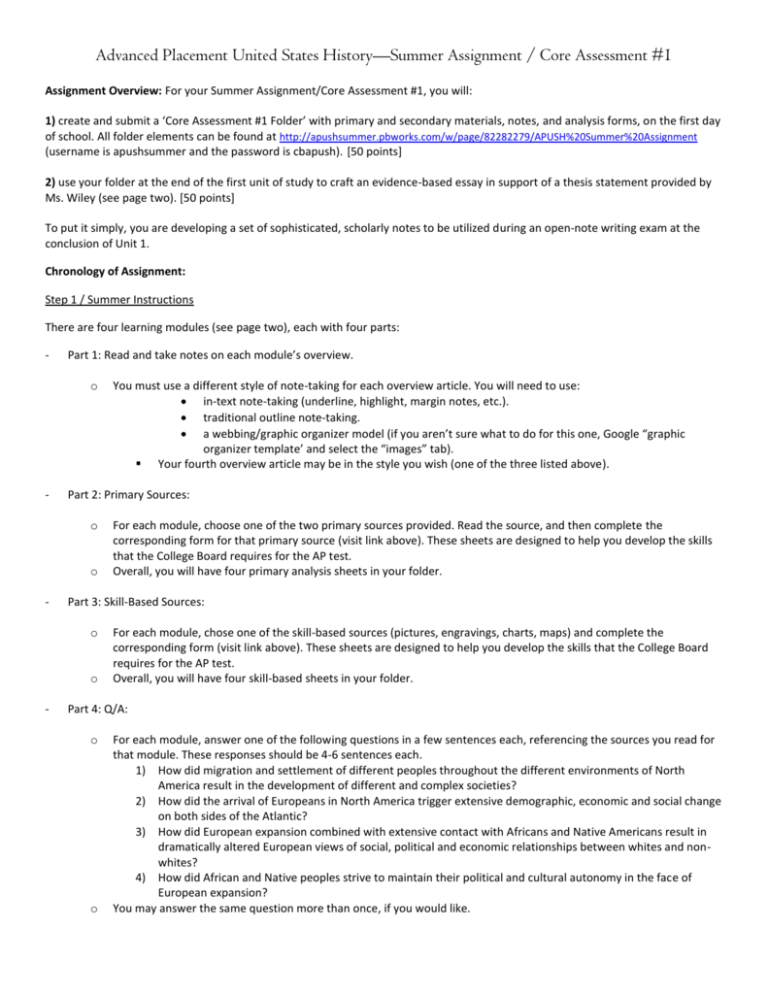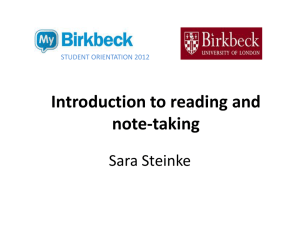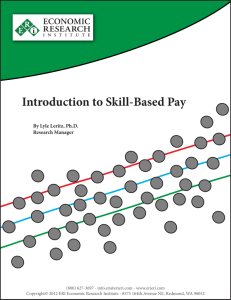Advanced Placement Summer Assignment/Core Assessment #1
advertisement

Advanced Placement United States History—Summer Assignment / Core Assessment #1 Assignment Overview: For your Summer Assignment/Core Assessment #1, you will: 1) create and submit a ‘Core Assessment #1 Folder’ with primary and secondary materials, notes, and analysis forms, on the first day of school. All folder elements can be found at http://apushsummer.pbworks.com/w/page/82282279/APUSH%20Summer%20Assignment (username is apushsummer and the password is cbapush). [50 points] 2) use your folder at the end of the first unit of study to craft an evidence-based essay in support of a thesis statement provided by Ms. Wiley (see page two). [50 points] To put it simply, you are developing a set of sophisticated, scholarly notes to be utilized during an open-note writing exam at the conclusion of Unit 1. Chronology of Assignment: Step 1 / Summer Instructions There are four learning modules (see page two), each with four parts: - Part 1: Read and take notes on each module’s overview. o - Part 2: Primary Sources: o o - For each module, choose one of the two primary sources provided. Read the source, and then complete the corresponding form for that primary source (visit link above). These sheets are designed to help you develop the skills that the College Board requires for the AP test. Overall, you will have four primary analysis sheets in your folder. Part 3: Skill-Based Sources: o o - You must use a different style of note-taking for each overview article. You will need to use: in-text note-taking (underline, highlight, margin notes, etc.). traditional outline note-taking. a webbing/graphic organizer model (if you aren’t sure what to do for this one, Google “graphic organizer template’ and select the “images” tab). Your fourth overview article may be in the style you wish (one of the three listed above). For each module, chose one of the skill-based sources (pictures, engravings, charts, maps) and complete the corresponding form (visit link above). These sheets are designed to help you develop the skills that the College Board requires for the AP test. Overall, you will have four skill-based sheets in your folder. Part 4: Q/A: o o For each module, answer one of the following questions in a few sentences each, referencing the sources you read for that module. These responses should be 4-6 sentences each. 1) How did migration and settlement of different peoples throughout the different environments of North America result in the development of different and complex societies? 2) How did the arrival of Europeans in North America trigger extensive demographic, economic and social change on both sides of the Atlantic? 3) How did European expansion combined with extensive contact with Africans and Native Americans result in dramatically altered European views of social, political and economic relationships between whites and nonwhites? 4) How did African and Native peoples strive to maintain their political and cultural autonomy in the face of European expansion? You may answer the same question more than once, if you would like. Step 1 Recap: - Core Assessment #1 folder is due on the first day of class. Your folder must include: o four overview articles with evidence of different styles of note-taking/interaction with the text o four primary analysis sheets o four skill-based sheets o four answers to chosen questions, with evidence from the sources Step 2 / Unit 1 Assessment At the end of Unit 1 (approximately 1.5 weeks into class), your Core Assessment #1 folder will be returned to you. You will use this work, along with your notes from the unit, to create an evidence-based essay in support of one of the following thesis statements. You will have 90 minutes to write this essay in class. The Theses: 1) 2) 3) On a North American continent controlled by American Indians, contact among the peoples of Europe, the Americas and West Africa created a new world. European overseas expansion resulted in the Columbian Exchange, a series of interactions and adaptations among societies across the Atlantic. Contacts among American Indians, Africans and Europeans challenged each group to maintain their own religious, cultural, political and cultural values. Keep yourself organized! Use this checklist to keep track of which documents you’ve chosen! FOLDER CHECKLIST OVERVIEW PRIMARY SOURCE (Choose 1) SKILL-BASED SOURCE (Choose 1) MODULE #1: NATIVE LIFE PRE-1492 Change and Crisis: North America on the Eve of European Invasion ____ In-text note-taking (underline, highlight, etc.) ____ Traditional outline note-taking _____ Webbing/graphic organizer model _____Oral Tradition, Foundation of the Iroquois Confederacy _____Native American Life (Documents 6-8), Nature’s Balance, Indian Complaints _____ Map: Native Cultures of North America 600-1500 _____ Image: Native American Lives MODULE #2: COLUMBIAN EXCHANGE The Columbian Exchange MODULE #3: ENGLISH COLONIZATION The Coming of the English ____ In-text note-taking (underline, highlight, etc.) ____ Traditional outline note-taking _____ Webbing/graphic organizer model _____Christopher Columbus, Report on First Voyage _____Bartolome de las Casas, Indictment of the Conquistadores ____ In-text note-taking (underline, highlight, etc.) ____ Traditional outline note-taking _____ Webbing/graphic organizer model _____ Image: Columbus Landing, 1492 _____ Map: European Exploration of North America, 1500-1783 _____ Image: Savagism in European Imagination _____ Map: Native American Tribes of North America on the Eve of Columbus _____Plymouth Settlers Agreement with Indians _____Walter Raleigh, English Approach to the Caribbean Indians MODULE #4: JAMESTOWN Jamestown and the Founding of English America ____ In-text note-taking (underline, highlight, etc.) ____ Traditional outline note-taking _____ Webbing/graphic organizer model _____John Smith, The Starving Time _____George Percy, Observations on Jamestown’s Early Months _____ Chart: Virginia Population Characteristics (1625) _____ Map: Interactive Jamestown Advanced Placement Summer Assignment/Core Assessment #1 Scoring Rubric Part 1 -- Summer (50 points) [Due first day of class] □ Four completed outlines (in different styles) for Part 1 (10 points) □ Four completed sheets for Part 2 (10 points) □ Four completed sheets for Part 3 (10 points) □ Four answers for Part 4 (20 points) Writing Quality (50 points) Organization Advanced 10-9 Well-structured introduction that provides purposeful context. Supporting paragraphs that are clearly and consistently related to thesis. Proficient 8-7 Structured introduction that provides relevant context. Supporting paragraphs related to thesis. Structured conclusion that reaffirms thesis. Basic 6 Poorly structured introduction that provides vague or irrelevant context. Supporting paragraphs not logically related to thesis. Poorly structured conclusion that inadequately reaffirms thesis. Well-structured conclusion that strongly reaffirms thesis. Below Basic 5-0 Incomplete or missing introduction. Body paragraphs do not relate to the prompt. Irrelevant or missing conclusion. Content Advanced 35-32 Proficient 31-25 Basic 24-21 Summer Content - References specific and substantial evidence to address the prompt. Evidence is factually accurate. Errors are minor. Summer Content - References sufficient evidence to address the prompt. Evidence is factually accurate. Errors do not detract from the overall purpose. Summer Content - References insufficient evidence to address the prompt. Evidence has errors that detract from the overall purpose. Unit Evidence - References specific and substantial evidence to address the prompt. Evidence is factually accurate. Errors are minor. Unit Evidence - References sufficient evidence to address the prompt. Evidence is factually accurate. Errors do not detract from the overall purpose. Unit Evidence - References insufficient evidence to address the prompt. Evidence has errors that detract from the overall purpose. Advanced 5 Clear and understandable writing. Proficient 4 Mostly clear and understandable writing. Basic 3 Writing is somewhat difficult to understand. Below Basic 2-0 Writing is difficult to understand. Evident control of grammar, mechanics, spelling, usage, and sentence formation. Adequate control of grammar, mechanics, spelling, usage, and sentence formation. Limited control of grammar, mechanics, spelling, usage, and sentence formation. Paragraphs flow smoothly and transitions are effective. Paragraphs flow and transitions are evident. Citations formatted correctly with minimal errors. Citations formatted with some errors. Paragraphs do not flow and transitions are ineffective / missing. Minimal to no control of grammar, mechanics, spelling, usage, and sentence formation. Works cited page formatted correctly with minimal errors. Works cited page formatted with some errors. Below Basic 20-0 Summer Content - References minimal or no evidence. Evidence has substantial errors that seriously detract from the overall purpose. Unit Evidence - References minimal or no evidence. Evidence has substantial errors that seriously detract from the overall purpose. Conventions Formatting of citations is inconsistent. Formatting of works cited page is inconsistent. Limited paragraphing and no transitions There is no attempt at formatting citations. There is no works cited page.






